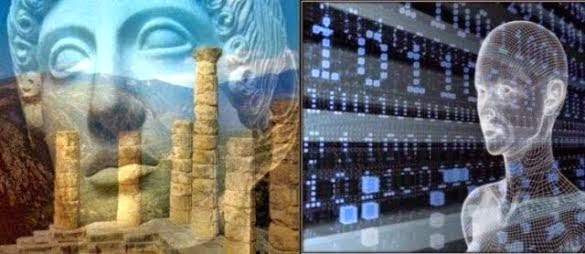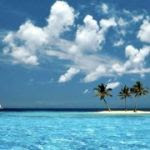The island of Delos, isolated in the centre of the roughly circular ring of islands called the Cyclades, near Mykonos, is one of the most important mythological, historical and archaeological sites in Greece.
The excavations in the island are among the most extensive in the Mediterranean; ongoing work takes place under the direction of the French School at Athens and many of the artifacts found are on display at the Archaeological Museum of Delos and the National Archaeological Museum of Athens.
Delos had a position as a holy sanctuary for a millennium before Olympian Greek mythology made it the birthplace of Apollo and Artemis. From its Sacred Harbour, the horizon shows the two conical mounds that have identified landscapes sacred to a goddess in other sites: one, retaining its pre-Greek name Mount Kynthos, is crowned with a sanctuary of Dionysus.
Established as a cult centre, Delos had an importance that its natural resources could never have offered. In this vein Leto, searching for a birthing-place for Artemis and Apollo, addressed the island:
Delos, if you would be willing to be the abode of my son Phoebus Apollo and make him a rich temple --; for no other will touch you, as you will find: and I think you will never be rich in oxen and sheep, nor bear vintage nor yet produce plants abundantly. But if you have the temple of far-shooting Apollo, all men will bring you hecatombs and gather here, and incessant savour of rich sacrifice will always arise, and you will feed those who dwell in you from the hand of strangers; for truly your own soil is not rich.
—Homeric Hymn to Delian Apollo
Remains of a settlement found on top of Mt. Kinthos show that Delos was inhabited since the 3rd millenium BC. Originally known as Ortygia (Quail Island), it was a religious center and busy port from ancient times. Although a barren island with virtually no natural resources, its harbors are protected by the three islands that circle around it (the Cyclades) and it is conveniently located between the Greek mainland and the Asian coast.
According to Greek mythology, Delos was the birthplace of Artemis and Apollo, the twin offspring of Zeus by Leto. When Leto was discovered to be pregnant, Zeus' jealous wife Hera banished her from the earth, but Poseidon took pity on her and provided Delos as a place for her to give birth in peace.
The Ionians colonized Delos around 1000 BC and made it their religious capital. The island was so sacred that, at one point, no one was allowed to be born or to die there - those about to do either were rushed off to the nearby islet of Rinia. A great festival, the Delia, was hosted here in honor of Apollo, Artemis and Leto, as described in Homeric Hymn 3.
By the 7th century, Delos was also the political capital of the Amphictionic League. The Athenians soon joined the league and assumed control, giving the Delians trouble on a regular basis until around 315 BC, when the Egyptians became the rulers of the Aegean Sea.
Delos was most prosperous in Late Hellenistic and Roman times, when it was declared a free port and became the financial and trading center of the Mediterranean. By 100 BC the island had a population of 30,000, which included foreigners from as far away as Rome, Syria, and Egypt. Each group built its own shrines and lived in relative harmony despite their differences. By Roman times, the island's commercial role exceeded its previous religious importance.
But in 88 BC Mithridates, the king of Pontus, attack on the unfortified island as part of a revolt against Roman rule. The entire population of 20,000 was killed or sold into slavery, the sanctuary treasures were looted, and the city was razed to the ground. The Romans partially rebuilt the city, but revival was prevented by continous pirate raids.
A Roman legate built defensive walls around the city in 66 BC, but by then Delos was on its way out. It was gradually abandoned in the centuries that followed. In the 2nd century AD, Pausanius recorded that it was inhabited only by the temple guards.
Delos was never forgotten, however, which meant further destruction and looting by the successive rulers of the area - pirates, Knights of St. John, Venetians, Turks - as well as its neighbors Mykonos and Tinos. In the 17th century, Sir Kenelm Digby removed some marbles from Delos for the collection of Charles I.
Formal excavation work began in 1872 by the French School of Archaeology, which still continues today. The island is still uninhabited except for the French archaeologists and site guardians.
Boats from Mykonos arrive on the west coast of Delos Island, in the Commercial Harbor near the south end of the ruins. The island is small, only 1.2km wide and covering 5 sq km of barren, hilly landscape.
The ruins of ancient Delos extend north and south along the coast and consist of four main areas: the Maritime Quarter (next to the harbor); Theater District (southeast of the harbor); Sanctuary of Apollo (north of the harbor in the center of the site); and Lion District (north end of the ruins). A small tourist center in the Sanctuary of Apollo includes a pricey restaurant and bar, but no overnight accommodations. Informational signs among the ruins are in Greek and French.
Panorama photo 6950 x 650 :
Photo Gallery with 100 Photos of Delos Here : www.sacred-destinations.com
































Post A Comment:
0 comments: